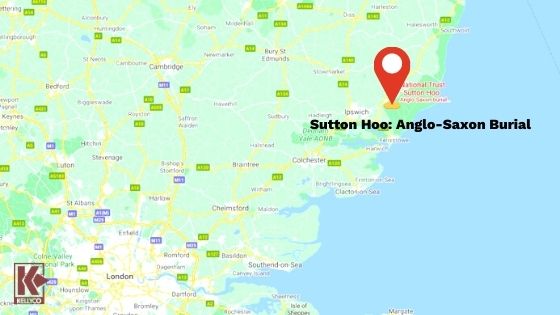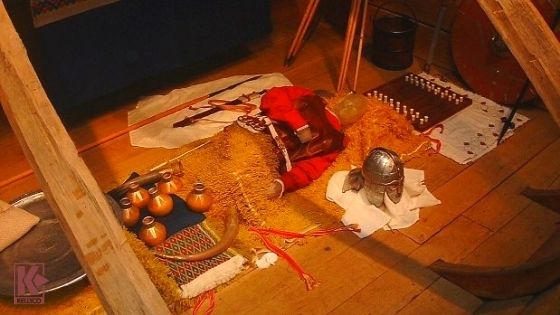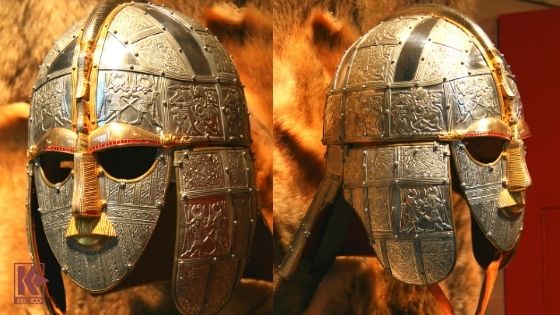Sutton Hoo Treasure: One of the Richest Treasures Ever Found in British Soil
Published by Sam Jacobs on 04/22/21
What do you do when you have multiple Anglo-Saxon burial mounds on your property? You ask your local archaeologist to come by and check it out. And what if he happens to find one of the biggest treasures of the era? Well, we don’t have to speculate, because this actually happened. The Hoxne Hoard might have led to a change in the British law regarding uncovered antiquities, but the Sutton Hoo Treasure changed how the British were able to understand their history. Indeed, it’s difficult to know where to even get started explaining the story of the Sutton Hoo Treasure because it is so deeply embedded into the history of the time.
The Anglo-Saxon Way of Death

Map of Sutton Hoo: Anglo-Saxon Burial
The short background is that after the Romans began withdrawing from Great Britain, the native Britons were faced with invaders from the east — the Angles, Saxons, and Jutes, who have become collectively known as “the Anglo-Saxons.” It is believed by historians that their earliest landings and heaviest areas of settlement were in East Anglia, which is where the Sutton Hoo Treasure was unearthed.
Now it’s worth explaining a little bit about the Anglo-Saxons with regard to their religious views. The Anglo-Saxons were pagans with religious traditions not altogether different from their Viking cousins. What’s important about this is that it means they believed it was possible — indeed, advisable — to take one’s treasures with one into the next life. To that end, warriors were often buried with as much treasure as they weren’t going to pass onto their posterity.
The Excavation of the Sutton Hoo Treasure Begins
Fast forward to the dawn of World War II in Europe. Wealthy widow Edith Pretty is a landowner in the UK who knows that she has 18 Anglo-Saxon burial mounds on her property. So she calls up self-taught archaeologist Basil Brown. Edith was very familiar with archaeology, as she had traveled extensively throughout her youth. She paid Basil Brown 30 shillings a week, which is the equivalent of about $200 today. He was given two weeks to do some of his work.

Reconstruction of the burial chamber – Sutton Hoo
Brown initially worked the area with the assistance of Pretty’s gardening staff, which was extensive as Mrs. Pretty was a woman of some means. He was able to excavate three of the mounds and found evidence that they were being robbed as late as the medieval period. The first mound (confusingly called Mound 3) was interesting, but not terribly impressive — a lot of pottery, mostly, which while valuable during the Anglo-Saxon period of interest to historians today, is not terribly valuable.
It was the second mound (Mound 2) that changed the nature of the excavation. It was here that signs of a large ship began to emerge in the form of rivets at first, but later other parts, perhaps most impressively a gold-plated shield boss. Mound 4 yielded nothing other than the knowledge that it had been completely stripped by graverobbers over the years. Brown put an end to his work but returned a year later due to curiosity that was spurred by Mound 2.
But when Mound 1 began excavation a year later, it wasn’t the dig that had changed — it was the entire conception of British history. It was here that what a British Museum curator later called “one of the most important archaeological discoveries of all time” began to take shape. What was unearthed there was a 7th-century Saxon ship, which may have been the last resting place of King Rædwald of East Anglia.
Unfortunately, the body is missing but testing of the soil suggests that the body was once there and that it wasn’t stolen, but rather that it simply decomposed completely due to the high acidity levels in the soil.
Brown handed the excavations off to the professionals, believing that he had reached the limit of his abilities.
Why the Sutton Hoo Treasure Is Important

Sutton Hoo Anglo-Saxon Helmet
So why was the Sutton Hoo Treasure so impressive? It wasn’t the value of the items found, despite the fact that these were quite valuable in and of themselves. No, the Sutton Hoo Treasure is more of an archaeological treasure than a financial one. The 90-foot ship was as intact as one could reasonably expect from a ship that was over 1,000 years old. The iconic Sutton Hoo Helmet, which adorns the covers of untold books about the Anglo-Saxons or the British Museum, was found in the Sutton Hoo Treasure.
There were other helmets, along with spoons, bowls, weapons, and other effects including textiles. So why did this change the understanding of British history?
The main reason is that the early Anglo-Saxon period was understood to be a “Dark Age” of English history, but the uncovering of the Sutton Hoo Treasure proved that there was a vibrant cultural life during this period.
The ship contained items not just from the Anglo-Saxon kingdoms of England, but from around the world, showing how far-traveled the Anglo-Saxon people were. Both Scandinavian and Byzantine objects were found in the treasure ship.
What’s more, the Sutton Hoo Treasure shed some additional light on another somewhat recent discovery of Britain’s Anglo-Saxon past — Beowulf. When the site was uncovered, literature scholars noted how closely the burial site matched up with burial reports in the Anglo-Saxon epic poem.
The final fate of the Sutton Hoo Treasure? It sits today in the British Museum, where it has lived ever since it was gifted by Mrs. Pretty. An inquest found that the objects belonged to her and her alone, but rather than keep them or even sell them, the already wealthy Mrs. Pretty simply gifted them to the museum. Winston Churchill later offered her a CBE for her service to the British Empire, but she declined to accept the award.
Nowadays, anyone can visit the Sutton Hoo Treasure at the British Museum or stomp around the area where the burial mounds were unearthed. No one got rich and no one got famous, but the Sutton Hoo Treasure became a symbol of British culture extending back over 1,000 years.

